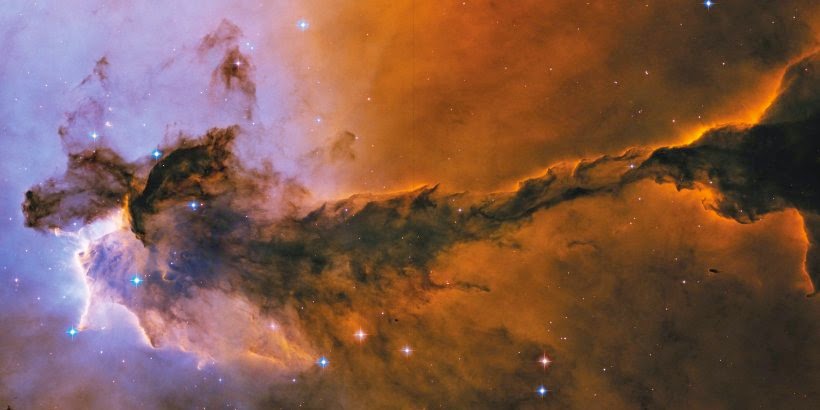Hubble is a telescope that orbits Earth. "Over the past 25 years, Hubble has been both a scientific marvel and a gallery of wonder, shedding light on dim places, and sending back gorgeous pictures that are expanding human knowledge and reminding us of Earth's tiny and precious place in the cosmos", writes Charles F. Bolden, Jr. And Owen Edwards states (in his essay "The Color of Chaos"): "The Hubble has seen deeper into space and farther back in time than any of humanity's questing eyes, and its unexpected gift is that in addition to great science the telescope is making great art – art like nothing ever seen before."
Spiral Galaxy
Distance from Earth 220,000,000 light years
So what exactly has Hubble taught us? It has empowered astronomers to make a far more precise estimate of the age of the universe. It has shown that the universe is expanding. And, it has revealed thousands of galaxies.
And what, by the way, is a galaxy? This is what Wikipedia says: "A galaxy is a gravitationally bound system consisting of stars, stellar remnants, interstellar gas and dust, and dark matter." The galaxy in which the microdot called Earth travels is called Milky Way and is 100,000 light-years across. Needless to say, this is way beyond my imagination. And the fact, as mentioned above, that Hubble has revealed thousands of galaxies makes me shiver. Especially, when thinking of the famous quote by the science fiction writer Arthur C. Clarke: "Two possibilities exist: either we are alone in the Universe or we are not. Both are equally terrifying." Well, given all these galaxies, it looks more likely that we are not alone.
Star-forming Nebula
Distance from Earth 6,500 light years
What we see in the pages of this book is not what Hubble has sent to Earth. "The telescope 'sees' the visual universe, which has color (hot stars are blue, for instance, and cooling stars are red); the pictures astronomers receive are in black and white. Then, using a variety of filters and other data collected by Hubble, including infrared light, microwaves, X rays, and gamma rays, color images are produced. None of the colors are entirely arbitrary ...".
Whether or not these fabulous images (that are astronomical facts) should be considered art (a question that Owen Edwards ponders in his essay) isn't really what's on my mind when spending time with these pics. Instead, I feel overwhelmed by what I've been told. Let me repeat it: thousands of galaxies and in one of these travels the microdot called Earth! My daily problems as an inhabitant of this microdot seem all of a sudden slightly less important. Well, sort of.
Star-forming Nebula
Distance from Earth 6,500 light years
Expanding Universe also contains a concluding statement by John Mace Grunsfeld, an astronaut on three of the five missions to Hubble, an interview with Zoltan Levay, who is in charge of transforming the data gathered from Hubble into photos and graphics, a photo index, a distance ladder, a glossary, information on the thirteen science instruments that Hubble carried along, and the biographies of the contributers to this tome.
Expanding Universe has very definitely altered my world-view. And, it will alter yours too!
Expanding Universe
Photographs from the Hubble Space Telescope
Taschen Cologne, 2015























No comments:
Post a Comment